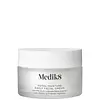What's inside
What's inside
 Key Ingredients
Key Ingredients

 Benefits
Benefits

 Concerns
Concerns

 Ingredients Side-by-side
Ingredients Side-by-side

Water
Skin ConditioningGlycerin
HumectantDimethicone
EmollientSqualane
EmollientCaprylic/Capric Triglyceride
MaskingBis-PEG-18 Methyl Ether Dimethyl Silane
EmollientPentaerythrityl Tetraethylhexanoate
EmollientPropanediol
SolventArachidyl Alcohol
EmollientCetearyl Alcohol
EmollientInulin
Skin ConditioningBehenyl Alcohol
EmollientPhenoxyethanol
PreservativeArachidyl Glucoside
EmulsifyingTocopheryl Acetate
AntioxidantCaprylyl Glycol
EmollientLinoleic Acid
CleansingSaccharomyces Ferment Filtrate
HumectantGlyceryl Glucoside
HumectantSodium Hyaluronate
HumectantAcetyl Heptapeptide-4
HumectantLinolenic Acid
CleansingCetearyl Glucoside
EmulsifyingSodium Polyacryloyldimethyl Taurate
Emulsion StabilisingDiglycerin
HumectantCeramide NP
Skin ConditioningSodium PCA
HumectantUrea
BufferingCarbomer
Emulsion StabilisingDisodium EDTA
Hydrogenated Polydecene
EmollientEthylhexylglycerin
Skin ConditioningXanthan Gum
EmulsifyingAcrylates/C10-30 Alkyl Acrylate Crosspolymer
Emulsion StabilisingSodium Hydroxide
BufferingLactic Acid
BufferingLysine
Skin ConditioningPCA
HumectantSorbitol
HumectantButylene Glycol
Humectant1,2-Hexanediol
Skin ConditioningTrideceth-10
CleansingTocopherol
AntioxidantHydrolyzed Wheat Protein
Skin ConditioningAllantoin
Skin ConditioningOryza Sativa Lees Extract
Skin ConditioningWater, Glycerin, Dimethicone, Squalane, Caprylic/Capric Triglyceride, Bis-PEG-18 Methyl Ether Dimethyl Silane, Pentaerythrityl Tetraethylhexanoate, Propanediol, Arachidyl Alcohol, Cetearyl Alcohol, Inulin, Behenyl Alcohol, Phenoxyethanol, Arachidyl Glucoside, Tocopheryl Acetate, Caprylyl Glycol, Linoleic Acid, Saccharomyces Ferment Filtrate, Glyceryl Glucoside, Sodium Hyaluronate, Acetyl Heptapeptide-4, Linolenic Acid, Cetearyl Glucoside, Sodium Polyacryloyldimethyl Taurate, Diglycerin, Ceramide NP, Sodium PCA, Urea, Carbomer, Disodium EDTA, Hydrogenated Polydecene, Ethylhexylglycerin, Xanthan Gum, Acrylates/C10-30 Alkyl Acrylate Crosspolymer, Sodium Hydroxide, Lactic Acid, Lysine, PCA, Sorbitol, Butylene Glycol, 1,2-Hexanediol, Trideceth-10, Tocopherol, Hydrolyzed Wheat Protein, Allantoin, Oryza Sativa Lees Extract
Water
Skin ConditioningPropanediol
SolventGlycerin
HumectantGellan Gum
Niacinamide
SmoothingSodium Anisate
AntimicrobialSodium Levulinate
Skin ConditioningSalicylic Acid
MaskingSodium Ascorbyl Phosphate
AntioxidantLactic Acid
BufferingChamomilla Recutita Flower Extract
MaskingSodium Phytate
Sodium Hyaluronate
HumectantAloe Barbadensis Leaf Juice
Skin ConditioningCamellia Sinensis Extract
AntioxidantCitric Acid
BufferingPotassium Sorbate
PreservativeWater, Propanediol, Glycerin, Gellan Gum, Niacinamide, Sodium Anisate, Sodium Levulinate, Salicylic Acid, Sodium Ascorbyl Phosphate, Lactic Acid, Chamomilla Recutita Flower Extract, Sodium Phytate, Sodium Hyaluronate, Aloe Barbadensis Leaf Juice, Camellia Sinensis Extract, Citric Acid, Potassium Sorbate
 Reviews
Reviews

Ingredients Explained
These ingredients are found in both products.
Ingredients higher up in an ingredient list are typically present in a larger amount.
Glycerin is already naturally found in your skin. It helps moisturize and protect your skin.
A study from 2016 found glycerin to be more effective as a humectant than AHAs and hyaluronic acid.
As a humectant, it helps the skin stay hydrated by pulling moisture to your skin. The low molecular weight of glycerin allows it to pull moisture into the deeper layers of your skin.
Hydrated skin improves your skin barrier; Your skin barrier helps protect against irritants and bacteria.
Glycerin has also been found to have antimicrobial and antiviral properties. Due to these properties, glycerin is often used in wound and burn treatments.
In cosmetics, glycerin is usually derived from plants such as soybean or palm. However, it can also be sourced from animals, such as tallow or animal fat.
This ingredient is organic, colorless, odorless, and non-toxic.
Glycerin is the name for this ingredient in American English. British English uses Glycerol/Glycerine.
Learn more about GlycerinLactic Acid is another well-loved alpha hydroxy acid (AHA). It is gentler than glycolic acid but still highly effective.
Its main role is to exfoliate the surface of the skin by loosening the “glue” that holds dead skin cells together. Shedding those old cells leads to smoother, softer, and more even-toned skin.
Because lactic acid molecules are larger than glycolic acid, they don’t penetrate as deeply. This means they’re less likely to sting or irritate, making it a great choice for beginners or those with sensitive skin.
Like glycolic acid, it can:
Lactic acid also acts as a humectant (like hyaluronic acid). It can draw water into the skin to improve hydration and also plays a role in the skin's natural moisturizing factor (NMF) in the form of sodium lactate.
Studies show it can boost ceramide production to strengthen the skin barrier and even help balance the skin’s microbiome.
To get results, choose products with a pH between 3-4.
Lower strengths (5-12%) focus on surface exfoliation; higher strengths (12% and up) can reach deeper in the dermis (deeper, supportive layer) to improve skin texture and firmness over time.
Though it was originally derived from milk, most modern lactic acid used in skincare is vegan. It is made through non-dairy fermentation to create a bio-identical and stable form suitable for all formulations.
When lactic acid shows up near the end of an ingredient list, it usually means the brand added just a tiny amount to adjust the product’s pH.
Legend has it that Cleopatra used to bathe in sour milk to help reduce wrinkles.
Lactic acid is truly a gentle multitasker: it exfoliates, hydrates, strengthens, and brightens. It's a great ingredient for giving your skin a smooth, glowing, and healthy look without the harshness of stronger acids.
Read more about some other popular AHA's here:
Learn more about Lactic AcidPropanediol is an all-star ingredient. It softens, hydrates, and smooths the skin.
It’s often used to:
Propanediol is not likely to cause sensitivity and considered safe to use. It is derived from corn or petroleum with a clear color and no scent.
Learn more about PropanediolSodium Hyaluronate is hyaluronic acid's salt form. It is commonly derived from the sodium salt of hyaluronic acid.
Like hyaluronic acid, it is great at holding water and acts as a humectant. This makes it a great skin hydrating ingredient.
Sodium Hyaluronate is naturally occurring in our bodies and is mostly found in eye fluid and joints.
These are some other common types of Hyaluronic Acid:
Learn more about Sodium HyaluronateWater. It's the most common cosmetic ingredient of all. You'll usually see it at the top of ingredient lists, meaning that it makes up the largest part of the product.
So why is it so popular? Water most often acts as a solvent - this means that it helps dissolve other ingredients into the formulation.
You'll also recognize water as that liquid we all need to stay alive. If you see this, drink a glass of water. Stay hydrated!
Learn more about Water